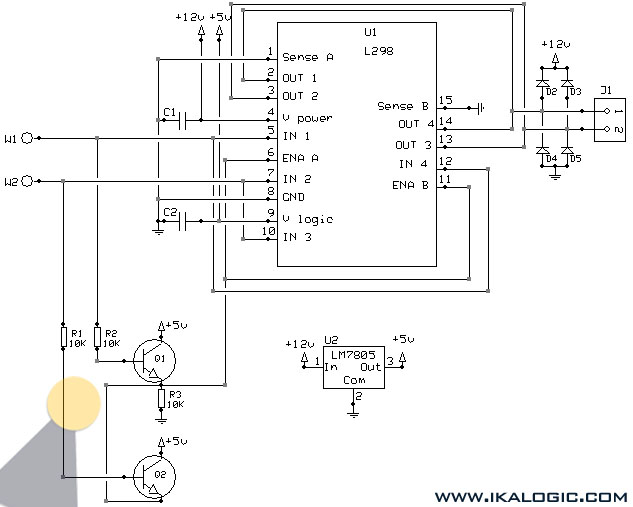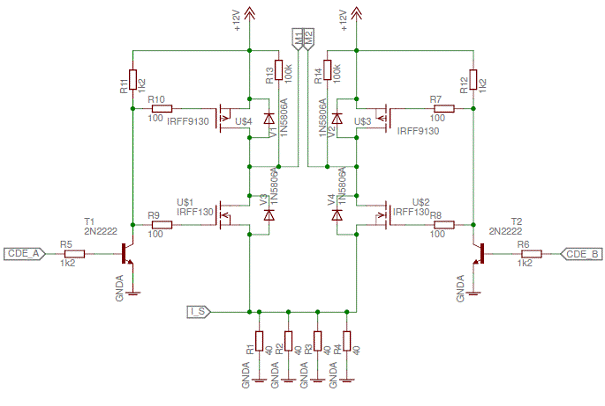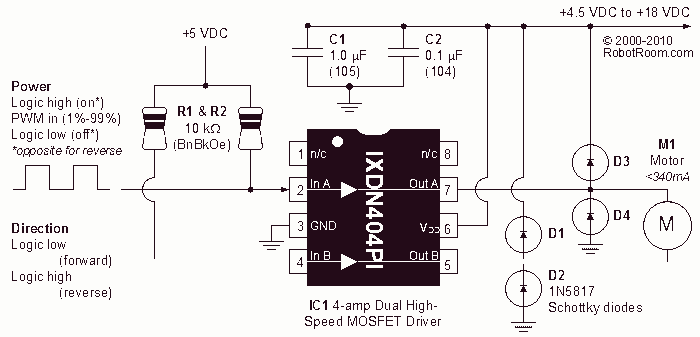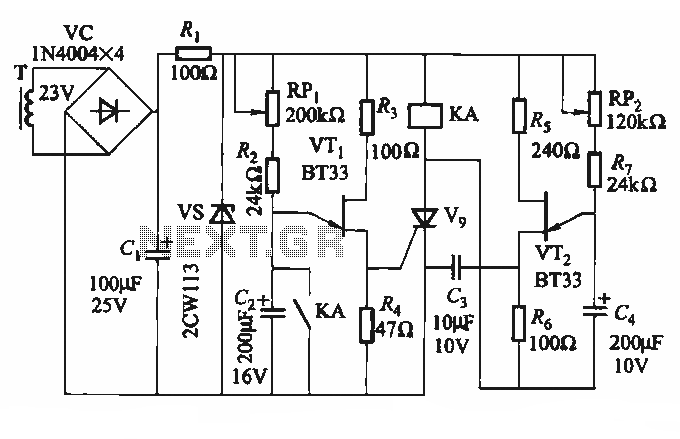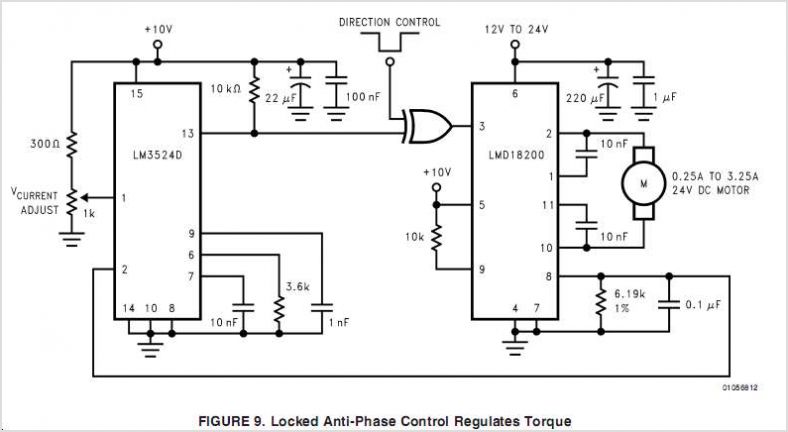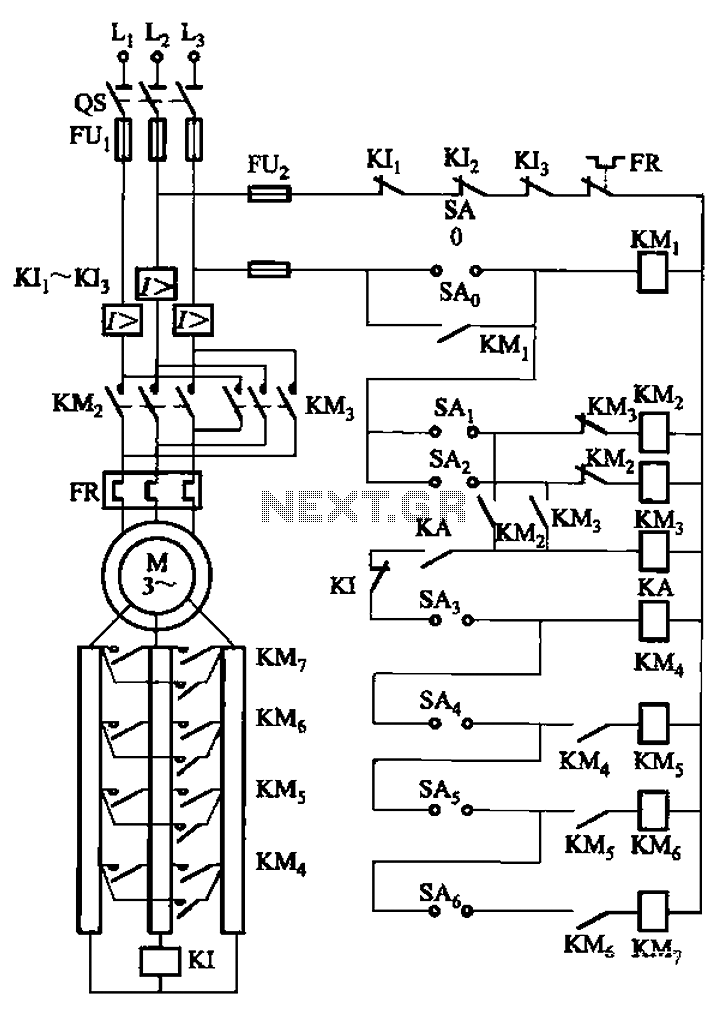
Wilf Rigter`s reversing H-bridge

This H-bridge variant was one of the first in which the reversing circuitry is built into the driver, rather than (as is more-commonly done) into the control circuitry upstream of the driver. This is a handy circuit, though, for 2-motor walkers -- as all that is required to reverse one is to reverse the phasing of one of the motors.
The described H-bridge circuit is a pivotal component in motor control applications, particularly for robotic systems such as two-motor walkers. An H-bridge allows for bidirectional control of DC motors by enabling current to flow through the motor in either direction. This specific variant distinguishes itself by integrating the reversing circuitry directly within the driver, streamlining the design and reducing the complexity typically associated with external control circuitry.
In this configuration, the H-bridge consists of four switches, typically implemented using transistors or MOSFETs, arranged in an 'H' shape. The two motors are connected across the horizontal legs of the 'H', while the vertical legs are connected to the power supply and ground. By controlling the state of the switches, the circuit can reverse the polarity applied to the motor terminals.
For a two-motor walker, the ability to reverse one motor independently allows for more versatile movement patterns. To achieve this, the control logic can be designed to selectively activate the switches associated with the motor that requires reversal. For instance, if one motor is to be reversed, the switches connected to that motor are toggled, while the other motor continues to operate in its original direction.
This approach simplifies the control strategy, as only one motor's phasing needs to be adjusted for directional changes, rather than managing complex control signals for both motors simultaneously. Consequently, the H-bridge variant enhances the efficiency of motor control in robotic applications, facilitating smoother and more responsive maneuvering capabilities.
Overall, this integrated design not only saves space on the circuit board but also reduces the number of components required, leading to a more compact and cost-effective solution for driving dual motors in robotic systems.This H-bridge variant was one of the first in which the reversing circuitry is built into the driver, rather than (as is more-commonly done) into the control circuitry upstream of the driver. This is a handy circuit, though, for 2-motor walkers -- as all that is required to reverse one is to reverse the phasing of one of the motors.
🔗 External reference
The described H-bridge circuit is a pivotal component in motor control applications, particularly for robotic systems such as two-motor walkers. An H-bridge allows for bidirectional control of DC motors by enabling current to flow through the motor in either direction. This specific variant distinguishes itself by integrating the reversing circuitry directly within the driver, streamlining the design and reducing the complexity typically associated with external control circuitry.
In this configuration, the H-bridge consists of four switches, typically implemented using transistors or MOSFETs, arranged in an 'H' shape. The two motors are connected across the horizontal legs of the 'H', while the vertical legs are connected to the power supply and ground. By controlling the state of the switches, the circuit can reverse the polarity applied to the motor terminals.
For a two-motor walker, the ability to reverse one motor independently allows for more versatile movement patterns. To achieve this, the control logic can be designed to selectively activate the switches associated with the motor that requires reversal. For instance, if one motor is to be reversed, the switches connected to that motor are toggled, while the other motor continues to operate in its original direction.
This approach simplifies the control strategy, as only one motor's phasing needs to be adjusted for directional changes, rather than managing complex control signals for both motors simultaneously. Consequently, the H-bridge variant enhances the efficiency of motor control in robotic applications, facilitating smoother and more responsive maneuvering capabilities.
Overall, this integrated design not only saves space on the circuit board but also reduces the number of components required, leading to a more compact and cost-effective solution for driving dual motors in robotic systems.This H-bridge variant was one of the first in which the reversing circuitry is built into the driver, rather than (as is more-commonly done) into the control circuitry upstream of the driver. This is a handy circuit, though, for 2-motor walkers -- as all that is required to reverse one is to reverse the phasing of one of the motors.
🔗 External reference
